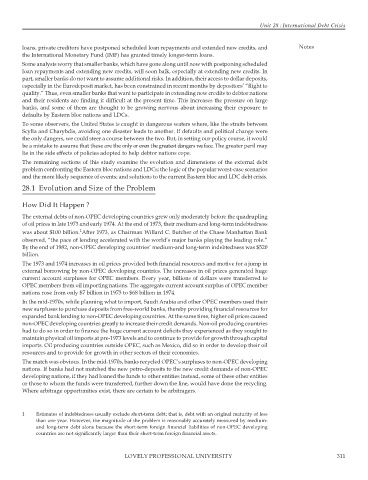Page 317 - DECO503_INTERNATIONAL_TRADE_AND_FINANCE_ENGLISH
P. 317
Unit 28 : International Debt Crisis
loans, private creditors have postponed scheduled loan repayments and extended new credits, and Notes
the International Monetary Fund (IMF) has granted timely longer-term loans.
Some analysts worry that smaller banks, which have gone along until now with postponing scheduled
loan repayments and extending new credits, will soon balk, especially at extending new credits. In
part, smaller banks do not want to assume additional risks. In addition, their access to dollar deposits,
especially in the Eurodeposit market, has been constrained in recent months by depositors’ “flight to
quality.” Thus, even smaller banks that want to participate in extending new credits to debtor nations
and their residents are finding it difficult at the present time. This increases the pressure on large
banks, and some of them are thought to be growing nervous about increasing their exposure to
defaults by Eastern bloc nations and LDCs.
To some observers, the United States is caught in dangerous waters where, like the straits between
Scylla and Charybdis, avoiding one disaster leads to another. If defaults and political change were
the only dangers, we could steer a course between the two. But, in setting our policy course, it would
be a mistake to assume that these are the only or even the greatest dangers we face. The greater peril may
lie in the side effects of policies adopted to help debtor nations cope.
The remaining sections of this study examine the evolution and dimensions of the external debt
problem confronting the Eastern bloc nations and LDCs; the logic of the popular worst-case scenarios
and the more likely sequence of events; and solutions to the current Eastern bloc and LDC debt crisis.
28.1 Evolution and Size of the Problem
How Did It Happen ?
The external debts of non-OPEC developing countries grew only moderately before the quadrupling
of oil prices in late 1973 and early 1974. At the end of 1973, their medium-and long-term indebtedness
1
was about $100 billion. After 1973, as Chairman Willard C. Butcher of the Chase Manhattan Bank
observed, “the pace of lending accelerated with the world’s major banks playing the leading role.”
By the end of 1982, non-OPEC developing countries’ medium-and long-term indebtedness was $520
billion.
The 1973 and 1974 increases in oil prices provided both financial resources and motive for a jump in
external borrowing by non-OPEC developing countries. The increases in oil prices generated huge
current account surpluses for OPEC members. Every year, billions of dollars were transferred to
OPEC members from oil importing nations. The aggregate current account surplus of OPEC member
nations rose from only $7 billion in 1973 to $68 billion in 1974.
In the mid-1970s, while planning what to import, Saudi Arabia and other OPEC members used their
new surpluses to purchase deposits from free-world banks, thereby providing financial resources for
expanded bank lending to non-OPEC developing countries. At the same time, higher oil prices caused
non-OPEC developing countries greatly to increase their credit demands. Non-oil producing countries
had to do so in order to finance the huge current account deficits they experienced as they sought to
maintain physical oil imports at pre-1973 levels and to continue to provide for growth through capital
imports. Oil producing countries outside OPEC, such as Mexico, did so in order to develop their oil
resources and to provide for growth in other sectors of their economies.
The match was obvious. In the mid-1970s, banks recycled OPEC’s surpluses to non-OPEC developing
nations. If banks had not matched the new petro-deposits to the new credit demands of non-OPEC
developing nations, if they had loaned the funds to other entities instead, some of these other entities
or those to whom the funds were transferred, further down the line, would have done the recycling.
Where arbitrage opportunities exist, there are certain to be arbitragers.
1 Estimates of indebtedness usually exclude short-term debt; that is, debt with an original maturity of less
than one year. However, the magnitude of the problem is reasonably accurately measured by medium-
and long-term debt alone because the short-term foreign financial liabilities of non-OPEC developing
countries are not significantly larger than their short-term foreign financial assets.
LOVELY PROFESSIONAL UNIVERSITY 311

